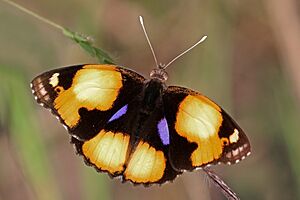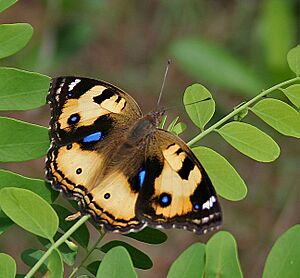Yellow pansy facts for kids
Quick facts for kids Yellow pansy |
|
|---|---|
 |
|
| Male, Semliki Wildlife Reserve, Uganda | |
 |
|
| Female, Andhra Pradesh, India | |
| Scientific classification | |
| Synonyms | |
|
The yellow pansy (scientific name: Junonia hierta) is a beautiful butterfly. It belongs to the nymphalid family, which is a large group of butterflies. You can find these butterflies in parts of Africa and Southeast Asia. They usually live in open areas like grassy fields and scrubland.
Contents
What Does It Look Like?
Male Yellow Pansy
The male yellow pansy butterfly is bright yellow on its upper side. Its front wings have a wide, black, triangle-shaped mark near the top. There's also a black edge that gets thinner towards the wing tip. This black edge has two small white stripes. Sometimes, you might see a faint eyespot below these stripes.
The back wings of the male are black at the front and along the outer edge. The part closest to its body is brownish. The black area on the back wing has a large, shiny blue spot. The tiny hairs along the edges of both wings are white and brown.
On the underside, the front wing is light yellow. It has three orange-yellow bars with black edges. There's also a wide, black band across the wing. The underside of the back wing is grayish-yellow. In the dry season, it might look dusty with dark spots. It has a wavy brown band and some faint marks near the body. The butterfly's feelers (antennae) are pale. Its head, body, and belly are dark brownish-black, but dull white underneath.
Female Yellow Pansy
The female yellow pansy looks a lot like the male, but her colors are not as bright. Her front wings have more black marks. She has clear eyespots with blue centers on her front wings. She also has smaller eyespots on her back wings.
Both her front and back wings have a light line near the edge. The blue spot on her back wing is smaller and not as clear as the male's. The underside of the female butterfly is similar to the male's. However, her markings are usually darker and easier to see.
Life Cycle
The yellow pansy goes through different stages as it grows.
Caterpillar (Larva)
The caterpillar (larva) of the yellow pansy is usually dark brown or gray. It has a wide stripe down its back made of tiny white and blue spots. Its spines, which are like little hairs, are black.
Pupa
After the caterpillar stage, it turns into a pupa. The pupa is a dull reddish color. Its head is rounded at the front. The part of its body where the wings will grow (thorax) is curved on top. Its belly has rows of small, dark spots.
Where Do They Live?
You can find the yellow pansy butterfly in many places. They live across Africa and in parts of Southeast Asia.
Different Types (Subspecies)
There are a few slightly different types of yellow pansy butterflies, called subspecies, found in various regions:
- Junonia hierta hierta (found in southern Yunnan, China)
- Junonia hierta cebrene (found in drier parts of Africa and Arabia)
- Junonia hierta paris (found in Madagascar)
- Junonia hierta magna? (found in Sikkim, India)
See also
- List of butterflies of India






